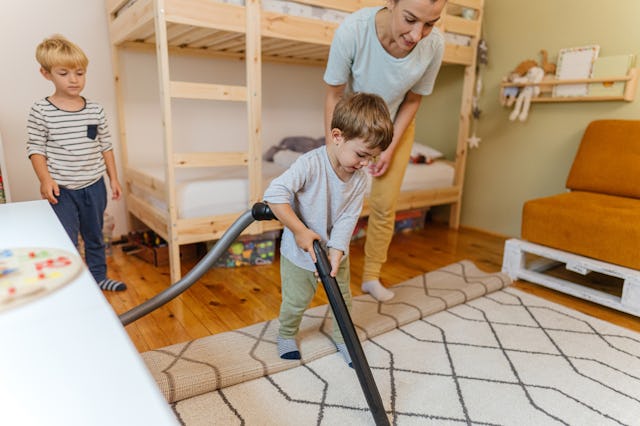Apparently, You Should Be Vacuuming Slower
Once again, slow and steady wins the race.

Who doesn't love a good cleaning hack? While so many have emerged from CleanTok (seriously, we learn something new every day), this vacuuming lesson is not so much a hack as it is a piece of sound advice. Evidently, the correct way to vacuum is to vacuum slowly, not fast. This stands true for all types of flooring, including rugs, carpets, hardwood, tile, and laminate.
If your childhood was anything like mine, then you know this goes against your parent's favorite chore day slogan: "Put some elbow grease into it!" Well, as it turns out, elbow grease is not the secret to a vacuum job well done.
The proper way is to vacuum unhurriedly, not in an aggressively tough manner. In fact, doing so will more than likely result in you having to re-vacuum the area because either you missed a spot or didn't give the vacuum time to, I don't know, actually do the one thing it's designed to do: pick up crap.
Why is vacuuming slower better?
As it turns out, slow and steady does win the race. Practicing slower movements allows the vacuum to kick up and therefore suck up more dirt and grime. Plus, all those residual crumbs from yesterday's playdate.
Vacuuming is often perceived as a quickie household chore, as is wiping down the countertops or sweeping the floor. These mundane tasks require minimal effort or concentration, but people often forget that vacuuming is actually a two-part job — loosening debris and then sucking it up.
So, what's the proper protocol for vacuuming?
Begin by slowly pushing the vacuum forward. During this step, the vacuum's bristles comb through the rug's fibers and bring dirt, dust, pet hair, and crumbs to the surface. Going slow gives the bristles adequate time to pick and pluck.
Next, in one slow and fluid motion, pull the vacuum back towards you. Slowly! You just spent all that time loosening the debris from the rug's nap; now, you want to ensure the vacuum has enough time to catch it all. If you race through this step, you run the risk of a dirty semi-finished product. Only it's worse because everything is visible for everyone to see — or, if you have a curious toddler, to grab.
"Don't vacuum like you are driving a race car," Rug Renovating president Paul Iskyan advised Today. The outlet reported that by adopting "slow, repetitive, overlapping strokes," you'll be removing "up to 85 percent of dust and allergens, while also making high-traffic patterns less noticeable."
When you start a new row, YouTube channel Clean Freak & Germaphobe recommends overlapping the previous row by 50% to suck up any stragglers that may have escaped. If you're really in the cleaning spirit, they also suggest repeating this whole process but in the opposite direction.
While vacuuming slower is more time-consuming, it'll prevent you from having to go over the whole area more than once (or twice if you're switching directions). Another added benefit is that you'll probably be able to go more days between vacuuming sessions now.
Looking for more vacuuming tips? Here are a few other easy ways you can step up your vacuum game:
- Always dust or wipe countertops before vacuuming.
- If you're vacuuming hardwood or tiled floors, sweep first.
- Use your whole body when vacuuming, not just your arms.
- Baking soda can help absorb odors that live in your carpet. Sprinkle baking soda on the carpet before you start vacuuming.
- Clean the bristles after every use.
- Empty out the vacuum every few uses or after you've vacuumed an area that's extra soiled.
- Change the vacuum's filter every few months.
- Use a handheld vacuum tool to clean hard-to-reach places, like the corners and along the baseboards.
The next time you reach for the vacuum, remember: slow is the way to go.
This article was originally published on